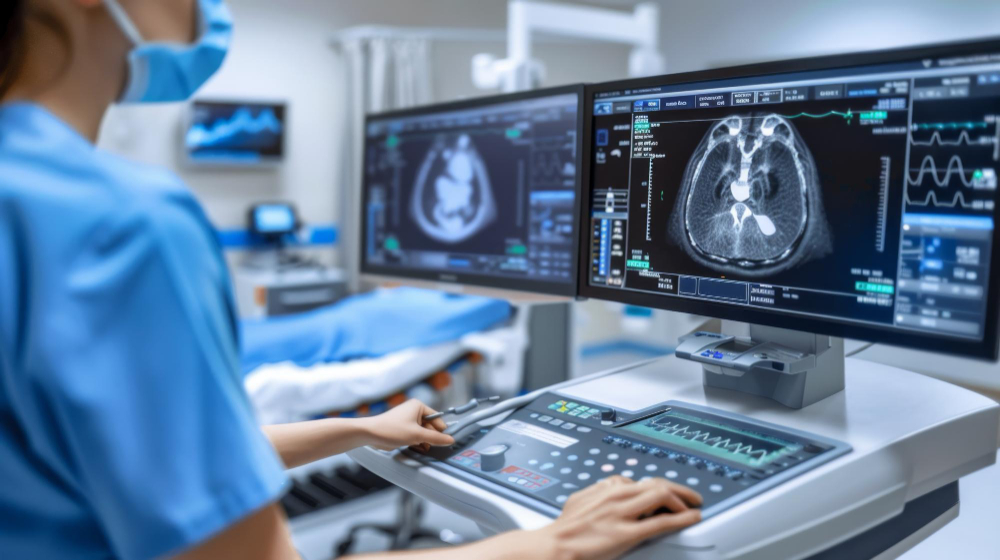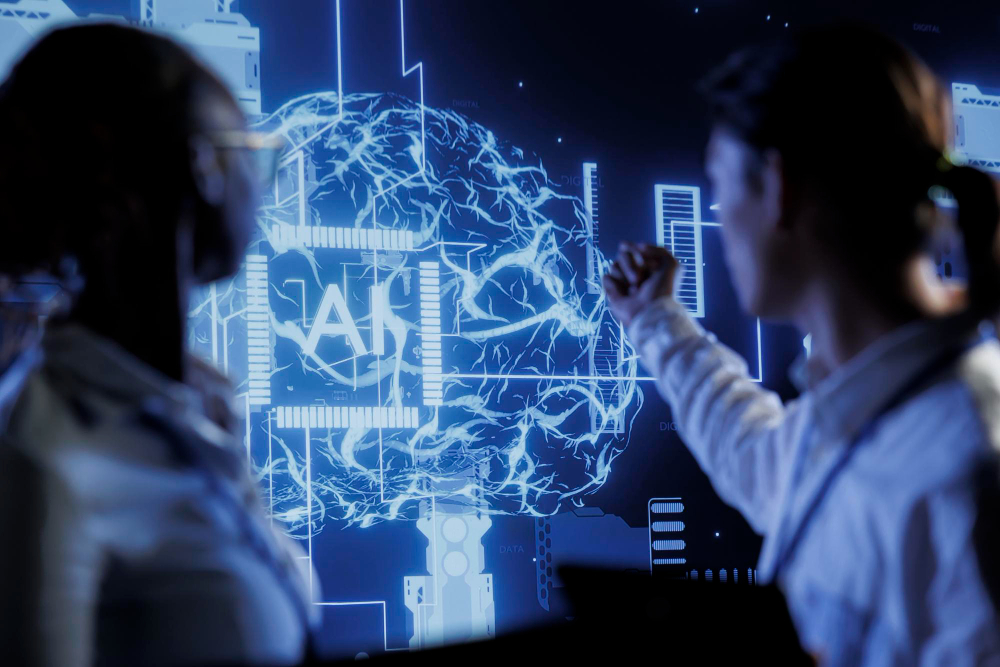Ultimate Guide to AI Software Development for Medical Imaging
Artificial Intelligence (AI) is transforming the field of medical imaging, offering powerful tools that enhance diagnostic accuracy, streamline workflows, and improve patient outcomes. According to Report Ocean, the global market for AI in medical imaging is expected to grow significantly, reaching an estimated $10.7 billion by 2030, driven by a rising demand for efficient diagnostic tools and advancements in AI technology.
As the healthcare industry increasingly embraces AI-driven solutions, the demand for specialized software that can utilize this technology is skyrocketing. However, developing AI software for medical imaging is a complex and nuanced process that requires a deep understanding of both cutting-edge AI technologies and the unique challenges of the medical field.
In this comprehensive guide, we’ll provide you with a deep understanding of AI software development for medical imaging
I. Understanding AI in Medical Imaging
Medical imaging software development involves creating software applications that analyze and interpret medical images, such as X-rays, CT scans, MRIs, and ultrasounds. These applications use advanced algorithms and techniques to assist healthcare professionals in diagnosing diseases, monitoring patient progress, and planning treatment.
With the help of AI, tasks that were previously performed manually are automated. AI algorithms, such as deep learning and machine learning, are trained on large datasets of medical images to learn patterns and features that are indicative of different diseases.
II. Benefits of AI Software Development for Medical Imaging
1. Improved Accuracy and Precision in Image Analysis
- Enhanced detection: AI algorithms can identify subtle abnormalities in medical images that may be missed by human experts.
- Reduced human error: AI can minimize errors caused by fatigue, subjectivity, or lack of expertise.
- Objective quantification: AI can provide quantitative measurements of disease progression, aiding in treatment monitoring and evaluation.
2. Faster Diagnosis and Treatment Planning
- Accelerated image analysis: AI can process medical images much faster than humans, enabling more rapid diagnosis and treatment decisions.

- Automated segmentation: AI can automatically segment images into different regions of interest, streamlining the analysis process.
- Optimized treatment plans: AI can help develop personalized treatment plans based on individual patient data and disease characteristics.
3. Enhanced Patient Outcomes
- Early detection: AI can detect diseases at earlier stages, leading to more effective treatments and improved outcomes.
- Improved accuracy: AI can increase the accuracy of diagnoses, reducing the risk of misdiagnosis and unnecessary procedures.
- Personalized care: AI can enable personalized treatment plans tailored to individual patients' needs.
4. Cost-Effective Solutions
- Reduced labor costs: AI can automate tasks that were previously performed manually, reducing the need for human labor.
- Improved efficiency: AI can streamline workflows, leading to increased efficiency and reduced costs.
- Resource optimization: AI can help optimize the use of medical resources, such as imaging equipment and personnel.
III. Key Steps in AI Software Development for Medical Imaging
Step 1: Defining the Problem and Use Case
The first step in developing AI for medical imaging is to clearly define the problem and establish a specific use case. This involves identifying the medical imaging challenges that AI can help address, such as enhancing disease detection, improving tumor segmentation, or identifying bone fractures.
Understanding the clinical context and needs is crucial, as it will guide the entire development process. Common use cases include detecting specific diseases, segmenting tumors for precise treatment planning, and analyzing fractures in bone scans. A well-defined use case helps ensure that the AI solution will be both clinically relevant and impactful.
Step 2: Data Collection and Preparation
The quality of data is foundational to successful AI development in medical imaging. High-quality, annotated medical imaging data enables the AI model to learn effectively. Data can be sourced from hospitals, medical research institutions, or publicly available datasets. Once collected, data must be preprocessed through steps like annotation, normalization, and augmentation.
Annotation involves labeling images to identify key areas of interest, while normalization ensures data consistency across samples. Augmentation techniques, such as rotating or flipping images, are used to artificially expand the dataset, helping the model generalize better and improving overall performance.

Step 3: Selecting the Right AI Model
Choosing the right AI model is essential for building an effective solution for medical imaging. Popular models include Convolutional Neural Networks (CNNs) for image classification and U-Nets for image segmentation.
When selecting a model, several factors must be considered, such as accuracy, processing speed, model size, and the hardware available for deployment. These considerations help balance the trade-offs between computational efficiency and model performance, ensuring that the chosen model meets the specific demands of the medical imaging application and can run effectively on the desired hardware infrastructure.
Step 4: Training the Model
Once the model is selected, training begins, which involves setting up an appropriate training environment. Depending on resource availability, this could be a local GPU setup, cloud-based environment, or specialized hardware.
During training, hyperparameter tuning and optimization techniques are employed to improve the model’s performance. Techniques like transfer learning, where pre-trained models are fine-tuned on specific medical imaging tasks, can also be useful, especially when dealing with limited data. It is crucial to address issues like data imbalance by employing methods such as oversampling or using weighted loss functions to ensure the model learns effectively from all classes.
Step 5: Evaluation and Validation
Evaluating and validating the model are critical steps to ensure its accuracy, robustness, and generalizability. Key metrics include accuracy, sensitivity, specificity, and area under the curve (AUC), which collectively provide insights into the model's performance.
Cross-validation, using multiple subsets of data, is often employed to assess how well the model generalizes. External validation sets are also important for testing the model on unseen data. Ethical considerations, such as mitigating biases that could impact patient outcomes, are essential throughout evaluation, helping to ensure that the model operates fairly and safely in clinical settings.
Step 6: Deployment and Integration
Deploying AI in healthcare environments presents unique challenges, including strict regulatory requirements and the need for seamless integration with existing systems. Popular deployment methods include on-premises setups for better control and security, cloud-based solutions for scalability, and edge computing for real-time processing.
Integrating the AI software with existing Picture Archiving and Communication Systems (PACS) and clinical workflows is essential to ensure that the AI tools are user-friendly and fit naturally into healthcare providers' daily routines. Proper deployment and integration are vital for translating AI models from development to real-world clinical applications.
IV. Key Applications of AI in Medical Imaging
Here are some popular applications of AI in Medical Imaging
1. Image Analysis and Segmentation
- Identifying abnormalities and lesions: AI algorithms can accurately detect abnormalities and lesions in medical images, such as tumors, cysts, or fractures.
- Quantifying disease progression: AI can measure changes in disease progression over time, providing valuable information for monitoring treatment response and making informed clinical decisions.
2. Computer-Aided Diagnosis (CAD)
- Assisting radiologists: CAD systems can help radiologists detect and classify diseases by highlighting potential areas of concern and providing additional information.
- Improving accuracy: CAD can reduce human error and improve the consistency of diagnoses, leading to more accurate and timely treatment decisions.
3. Image Reconstruction
- Improving image quality: AI can enhance image quality by reducing noise, artifacts, and blurring, making it easier for radiologists to interpret images.
- Increasing resolution: AI can increase the resolution of images, providing more detailed information about anatomical structures.
4. Personalized Medicine
- Tailoring treatment plans: AI can analyze patient data from medical images to develop personalized treatment plans based on individual characteristics and disease progression.
- Predicting outcomes: AI can predict disease outcomes and identify patients at high risk for complications, allowing for proactive interventions.
V. Challenges and Considerations in AI Software Development for Medical Imaging
1. Data Quality and Quantity
The quality and quantity of data are critical to the success of AI models in medical imaging. High-quality, labeled datasets are necessary to train AI algorithms effectively. However, obtaining sufficient data can be challenging due to privacy concerns, limited access to diverse datasets, and the cost of data annotation, which often requires specialized medical expertise. Furthermore, medical imaging data can vary significantly across institutions and patient demographics, making it difficult to create generalized models. Insufficient or poor-quality data can lead to models that lack accuracy or fail to perform well in real-world clinical settings.
2. Ethical Implications and Bias
AI in medical imaging raises ethical concerns, particularly around issues of bias and fairness. Bias can be introduced into AI models if the training data is not representative of diverse patient populations, potentially leading to disparities in diagnostic accuracy for certain groups.
For example, if a model is trained primarily on data from one demographic, it may perform poorly on others, leading to unequal healthcare outcomes. Additionally, the use of AI in healthcare must be transparent, with mechanisms for accountability and explainability to ensure that AI-driven decisions are fair and justifiable. Addressing these ethical issues requires ongoing evaluation, as well as collaboration with stakeholders from diverse backgrounds.
3. Regulatory Compliance
Medical imaging software that incorporates AI must comply with stringent regulatory requirements to ensure safety, efficacy, and patient privacy. Regulatory bodies, such as the FDA in the United States or the European Medicines Agency (EMA) in Europe, require thorough evaluation of AI models before they can be used in clinical settings.
This process includes validating the model’s performance, assessing its impact on patient care, and ensuring compliance with standards for patient data protection, such as HIPAA in the United States and GDPR in Europe. Navigating these regulatory frameworks can be complex and time-consuming, but it is essential to maintain the trust and safety of patients and healthcare providers.
4. Interoperability and Integration with Existing Systems
Successful deployment of AI software in medical imaging requires seamless integration with existing healthcare systems, such as Picture Archiving and Communication Systems (PACS) and Electronic Health Records (EHR). Interoperability challenges arise due to varying data formats, standards, and protocols used across different institutions.
Ensuring that AI software can communicate and operate effectively within these ecosystems is essential for maximizing its utility in clinical workflows. This often involves adhering to standards like DICOM for imaging and HL7 or FHIR for health information exchange. Addressing interoperability ensures that AI tools complement existing systems, enhancing their functionality without disrupting established workflows.
Read more: FHIR: Explore the Standard for Health Information Exchange in the Digital Era
VI. Future Trends and Innovations in Medical Imaging AI
The field of medical imaging is undergoing a rapid transformation, driven by advancements in Artificial Intelligence (AI). Beyond the existing applications and technologies discussed, several emerging areas hold significant promise for improving the accuracy, efficiency, and accessibility of medical diagnosis and treatment.
1. Explainable AI and Interpretability
One of the major challenges in AI-driven medical imaging is understanding how models arrive at their conclusions. Explainable AI (XAI) aims to make these models more transparent, allowing healthcare professionals to trust better and interpret AI-generated results. This is particularly important in critical applications like disease diagnosis and treatment planning. Techniques such as feature importance analysis, attention visualization, and rule-based explanations can help to clarify the reasoning behind AI models' decisions.

2. Generative AI for Medical Image Synthesis and Augmentation
Generative AI models, like Generative Adversarial Networks (GANs) and Variational Autoencoders (VAEs), can be used to generate synthetic medical images or augment existing datasets. This is valuable for addressing data scarcity, improving model performance, and protecting patient privacy by synthesizing data that preserves the statistical properties of real images without revealing sensitive information.
3. Edge AI for Real-Time Medical Imaging Analysis
Edge AI involves deploying AI models directly on medical devices, such as ultrasound machines or portable X-ray devices. This enables real-time analysis of images at the point of care, reducing latency and improving efficiency. Edge AI can be particularly useful in remote or resource-constrained settings, where sending images to a centralized server for analysis may not be feasible.
Wrap UP
As the healthcare industry continues to evolve, AI software development for medical imaging is poised to play an increasingly crucial role in improving patient outcomes and optimizing diagnostic workflows. From understanding the benefits and key applications of AI in medical imaging to challenges relating to data quality, and compliance, this guide has covered essential aspects of AI development in medical imaging. By understanding these elements, developers and healthcare professionals can leverage AI to deliver accurate, efficient, and personalized care.
If you're ready to bring cutting-edge AI solutions to your medical imaging projects, Ominext is here to help. With over 12 years of experience in healthcare and medical IT solutions, Ominext specializes in delivering tailored, innovative solutions that meet the unique needs of healthcare organizations. Contact us today to learn how our expertise can support your AI software development goals and help you stay ahead in the rapidly evolving world of medical imaging.





